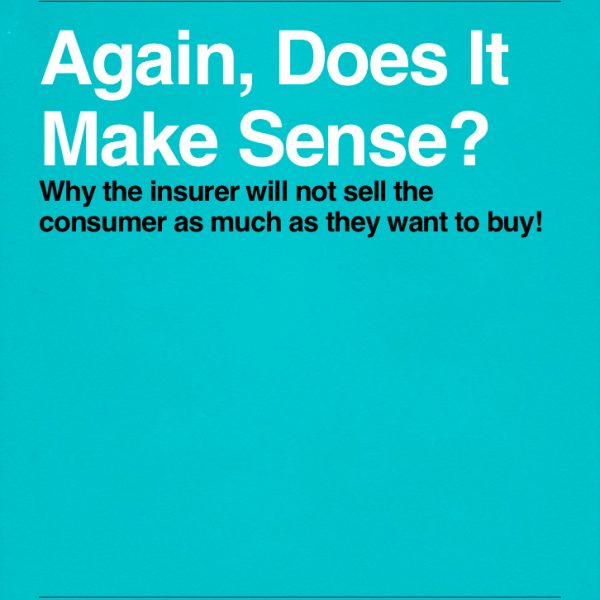(Make them disappear)
This Article was written in mid 2008 at the request of the editors of a magazine called Pravartak, the Journal of Insurance and Risk Management. A bit short as compared with many of my articles. Underwriting and its issues are so universal (be they the supply of top senior underwriters, the training of new underwriters, the communication between advisor and underwriter, the regulatory changes or the evolution of medicine) that articles, speeches and opinions are relevant in all insurance locales. The article was published in Volume III Issue 4, July-September 2008.
Learning to love the underwriting process or, at the least, learning to survive that thing life and health insurers do called risk selection! Just how does the financial planner and/or life agent get comfortable with the categorization of clients into the super good, better than average, non-smoking leftovers, smokers and really impaired lives? How does the underwriter get comfortable with the sales concepts of distribution, the whining of agents who feel oppressed by the arbitrary nature of risk of selection or the inability of agent to gather all the information both financial and medical from the applicant the first time? Surprisingly you, if you are the agent and the source of all sales, are not alone as even the neophyte rookie unblessed underwriting candidate struggles these days with learning the “ropes” of what has become a very complex subject. It is all about communication which by definition includes speaking and listening. As I wrote many years ago (this subject of communication or lack thereof between underwriter and agent) is far from new and far from being a problem limited to the Indian market. Just read “Two Hymn Books” at www.rossmorton.com .
The question asked by both those in the distribution channels and those trying to manage a new business process, which includes underwriting, has recently been answered by a company called LOGiQ3 Underwriting Solutions Inc. which tries to bridge the information chasm. This independent company stepped in to provide almost a mediation role in getting one underwriter (in the head office) to understand the other underwriter (agent in the field). Thus, for the underwriter to look to other markets for solutions is like looking at a shooting star and making a wish. No market from Canada to South Africa, USA to Great Britain, Hong Kong to Australia and so on and so forth has ever built solid communication between the two underwriters. I use the word underwriter for the agent as well since, in history, they were the first underwriters and are still the first line of risk selection an insurer has!
The increased interest in helping the agent or financial planner, in order to help themselves or their assistant prepare a case for underwriting, has grown tremendously. From asking questions and recording answers in a way to fast track issue to helping construct the covering letter for the most complex of medical and financial protection sales, those connected to any form of distribution want to know “how do you do that?” In Canada today it is common to hear an insurer say they are declining and/or rating as much as 20% of the applicants who cross their desks. Many an MGA has stated to me that close to 22% of applications are rated or declined. When the CLHIA kept statistics on such things up to a decade ago the number was less than 10%! This is the business that better communication can help the broker with through better preparation and case deployment. In addition to those obvious cases relegated to the bottom draw there are those large sums assured where wrestling with the underwriter to make them understand the need and justification is almost becoming an Olympic sport (possibly before women’s ski jumping). Ask many a great underwriter and they will say the case is often lost in the first instance an underwriter opens the file. Swelling the 80% placement ratio to more like the old days’ 90% represents a very large premium that currently does not reward the advisor. There are thousands of applications out there tht need more attention starting with those who did all the hard work to find them and get a signature on the application, perhaps and most likely after months of hard work.
India is no different than the rest of the insurance world in that communication skills for underwriters fall far down the on the list of qualities one looks for in underwriting talent. By their very nature the inquisitive sometimes introverted underwriter is a reader and closet doctor who would rather make a diagnosis than a sellable underwriting decision. I see no difference in the personas of Indian underwriters than I see in Canadian underwriters. As an industry we do not help the underwriter learn the skills of communication other than how to answer the phone with those opening pleasantries dictated by human resource departments. No where is the underwriter exposed to the much needed skills of communicating opinion in a nonthreatening fashion or making the agent feel in their mind and heart that they just experienced a quality decision which is both prudent and right.
Dressing up a diabetic case in the important facts to make it look like it really is and give the risk taker comfort that they know what the risk is can be accomplished with agent’s being taught how to build a file to support the application. To avoid issues at claim time how does the advisor cajole the right answers to each and every question from the applicant in a form that gives the risk taker (the home office underwriter is the bastion of risk selection) a broader tolerance in his or her action. What is trivial and what is not? What is helpful to differentiate your good hypertensive from the other advisors poor hypertensive? The answers are both through managing the information gathering process and “telling the story” when the story needs telling. Being forthright can be contagious and once the underwriter sees the information is forthcoming without aggravation they are on the agent’s side or should be.
In the book “Again, Does It Make Sense” by yours truly, there is the very real example of the multimillion dollar case that would never have made it through the underwriting process in tact if it had not been started with a great explanatory letter to the underwriter — insurer and reinsurer wanted to get the case issued for the amount applied for! A wise and entrepreneurial company works with agents one on one to get cases front and centre and then eventually through the process. The new philosophy in modern insurers is that it is very rewarding to train the agent on how to get some of that lost commission into their bank account and bring the satisfaction to the agent of having truly helped those some of us would say are the most in need.
In the 12 years just past I have had the great good fortune to visit India and see it take a giant step from single life insurer to multiple insurers and of course the ever present reinsurers. The change was meteoric with a stampede to get licensed, get staff, get product and get sales (not necessarily in that order as sales most likely raced far ahead of trained and qualified staff). With a lack of sufficient numbers of local experts, India imported the experts from other countries but with that importation of ideas and expertise came the baggage of past failures and lessons failed especially in communication. My first visits after the expansion to many insurers had me asking the questions of underwriters “Does your company train you in communications and dealing with agents?” The answer was an emphatic no! I was not surprised because none of these companies’ foreign partners practiced communication skills in their own markets. “Does your company train the agent on how to “sell” a case to the underwriter with detailed and forthright information both medical and financial?” Again the emphatic no since that skill in the overseas markets has all but disappeared. It seems bad habits are as easy to import as good habits.
With sales piling up on desks and there being no shortage of willing salespeople eager to hit the streets in soliciting overdrive, why waste time training them and underwriters to build strong relations through communication? Even the actuarial talent hardly knew underwriters existed and three “straw polls” done four years ago in Indian insurers showed no actuary admitted they had ever taken the time to communicate with underwriters on product pricing and margins. The underwriter was left to guess where and when to shave a table or two of rating. Thus I saw a failure to communicate both in the field relations and in the head office relations. How can an underwriter expect to do their job of categorizing risks without knowing the pricing foundation of those rate classes? We will worry about that when sales flatten and time permits. As an outsider sales will not flatten for years and years and thus the chasm will grow wider between the underwriter and the field agent plus the pricing actuary as they restructure prices to accommodate non-smokers and the super healthy (preferreds and super preferreds).
I was naïve in thinking India would be different and fundamental insurance education, both in technical knowledge and sales competency, would be different in India. You have thus far emulated the foreign practices of focusing on new sales, which is great as I am a believer in growing fast and furious, and foregoing building both internal and external communication avenues that negate lost sales and argumentative discourse between agent and underwriter. Perhaps unlike other insurance markets the effort will be expended sooner rather than later to bring sales and risk selection onto the same page as partners in growth and profit. The Indian market is tremendous in reality and potential and I reiterate that having seen the changes over just a decade I wish I could experience more of that exposure since growth is far more fun and rewarding than the contracting industry of North America. In the interim I have to be satisfied with the rare visit to a vibrant market that will be in many ways unique but in others will carry the same baggage as the rest of the insurance world.
Ross A. Morton, FLMI
Reassurer Advisor Mentor

